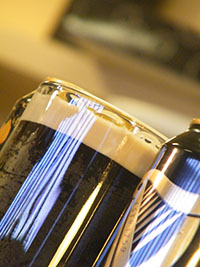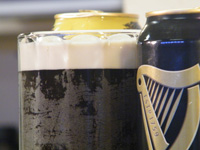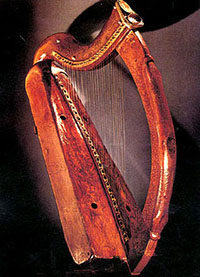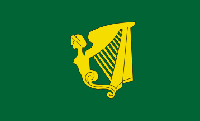 We haven’t done a beer cocktail yet; I’d say it’s nigh about time to feature one as our first. In our website logs, I saw that someone had been searching for something called an Irish Harp. After a little research, I found out exactly what this pub drink is. It fits in perfectly with St. Patrick’s week, so read onward, as we break down the recipe and discuss the history of the Irish harp.
We haven’t done a beer cocktail yet; I’d say it’s nigh about time to feature one as our first. In our website logs, I saw that someone had been searching for something called an Irish Harp. After a little research, I found out exactly what this pub drink is. It fits in perfectly with St. Patrick’s week, so read onward, as we break down the recipe and discuss the history of the Irish harp.
Irish Harp

- 1 part Guinness stout
- 1 part Irish hard cider
This stout and cider shandy is about as easy as it gets. Combine equal parts of Guinness stout and Irish hard cider in a tall pub glass. Some people may layer the cider on top, but for practical purposes, just mix them together as we do. Drink up and enjoy!
This is an ideal beer cocktail for when you’re trashed at the pub. Just order a pint of each, and you’re in business. Making the Irish Harp takes about a minute, if you do the recommended long Guinness pour from the widget can or the tap. The Irish Harp combines the darkness of Guinness stout and the tartness of hard cider. The Irish Harp is also a variation of a Snakebite, which is simply any beer and cider cocktail. I’m down for celebrating St. Patrick’s Day (or any day) with this beverage. The Irish Harp will go to your head quicker than you realize, so drink up, fella!
History and Meaning of the Irish Harp
 The Irish harp was thought to have been brought to Europe from Egyptian trading routes, and is one of the oldest instruments in Western culture. Ireland and Scotland both have a heritage with the Celtic harp, popular for it’s portability and versatility. These Celtic harps were strung with metal wire as opposed to other harps strung with gut strings. In Scotland, this style of harp is known as a clàrsach and in Ireland, an Irish harp. Celtic is the term most often used to describe these instruments, as Gaelic carries more of a Scottish connotation, even though that is a common root culture.
The Irish harp was thought to have been brought to Europe from Egyptian trading routes, and is one of the oldest instruments in Western culture. Ireland and Scotland both have a heritage with the Celtic harp, popular for it’s portability and versatility. These Celtic harps were strung with metal wire as opposed to other harps strung with gut strings. In Scotland, this style of harp is known as a clàrsach and in Ireland, an Irish harp. Celtic is the term most often used to describe these instruments, as Gaelic carries more of a Scottish connotation, even though that is a common root culture.
The lyre-like Irish harp was used by traveling minstrels and bards during the Middle Ages. The harp first appeared on Irish fourpence in the early 1500s. During the 1600s, when England began to creep into Ireland, the invading forces tried to suppress these musicians, as they feared the protest songs and rallying cries that would travel via the harp. Harpists actually feared for their lives, and Irish harps were confiscated and destroyed during these dark times. England eventually Anglo-cized the majority of Irish citizens, and the folk harps were not able to do a lot of the chromatic scales that were becoming popular in Baroque music of that time. The Irish harp culture might have been lost forever if not for a 1792 Belfast harping festival, where transcriber Edward Bunting was able to recover some of the old melodies before all the living Irish harpers faded into the void.
 The Irish harp is featured on the “Green Flag&38221; that was used from 1642 during the Irish Confederate Wars. This particular flag was also used during the Rebellion of 1798. The Erin Go Braugh flag featuring the Irish harp was used by the United Irishmen in 1803. Variations of this flag were used by Irish Nationalists resistant to rule by the English Crown up until the tricolor flag of green, white, and orange was adopted in 1916. Although the history of Ireland and the United Kingdom is complicated at best, Yanks could best liken the green harp flag to the “Don’t Tread On Me” flag, although that analogy is not exactly parallel. The harp remains a symbol of Irish nationalism to this day.
The Irish harp is featured on the “Green Flag&38221; that was used from 1642 during the Irish Confederate Wars. This particular flag was also used during the Rebellion of 1798. The Erin Go Braugh flag featuring the Irish harp was used by the United Irishmen in 1803. Variations of this flag were used by Irish Nationalists resistant to rule by the English Crown up until the tricolor flag of green, white, and orange was adopted in 1916. Although the history of Ireland and the United Kingdom is complicated at best, Yanks could best liken the green harp flag to the “Don’t Tread On Me” flag, although that analogy is not exactly parallel. The harp remains a symbol of Irish nationalism to this day.







